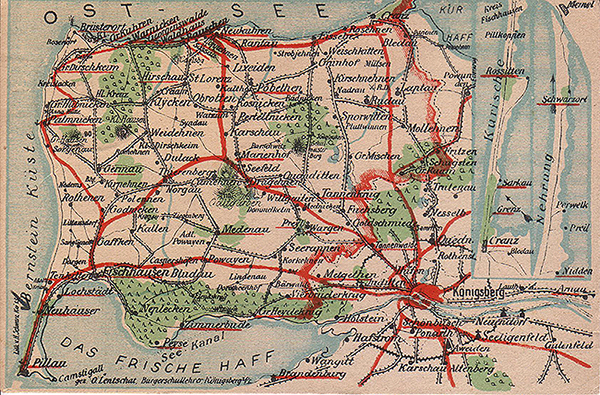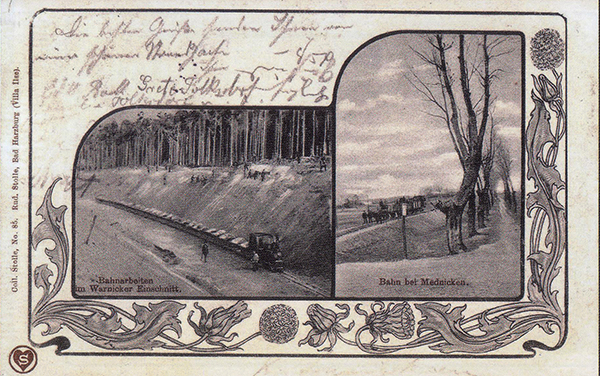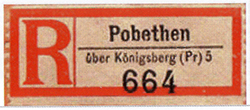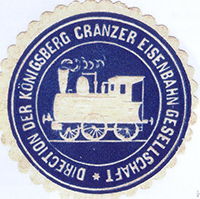Railways of Samland
With the opening of the Nuremberg-Fürth railway in 1835, the construction of steel tracks began in Germany. And by 1853, the railway lines had already reached the Samland Peninsula. Naturally, the main point was Königsberg, the capital of East Prussia. This meant that any line going to the main city of the province or starting in it passed through Samland. Here are some "milestones" in the annals of the birth of the lines:
1860 – construction of a route from the Eastern Station in Königsberg to Eydkuhnen (now Chernyshevskoye) on the German-Russian border.
1865 - the southern line branch Königsberg - Bartenstein (Bartoszyce) entered service, then the line was extended to Rastenburg (Kętrzyn), Lika (Elk), Prostken (Prostki) and later came to Brest.
1889 - On October 1, a railway line was opened between Königsberg and Labiau (Polessk); a year later, Tilsit (Sovetsk) was added to the line.
1895 - a branch line from Kranz to Kranzbeek (a suburb of Kranz) appears: to the pier of steamships plying the Curonian Lagoon.

More than 110 years ago, on July 14, 1900, the first train ran on the Samland Railway. This was a key moment in the development of seaside resorts on the northern coast, breathing new opportunities into the development of the economy of the north-eastern "corner" of the region. But just a little over a year before the first locomotive whistle on the new tracks, on April 13, 1899, the joint-stock company "Samland Railway" was founded in Königsberg. The authorized capital was 1.5 million marks, 1,500 shares with a par value of 1,000 marks each were issued. The concession decided that trains would run here at a maximum speed of 30 km/h. This was also required by the Railway Code adopted in 1892, which set a 30-kilometer limit for narrow-gauge steel tracks. Time took its toll and in 1901 the Imperial Ministry of Public Works approved an increase in speed to 40, and in the summer to 50 km per hour. Of course, this sped up the movement.

The tracks ran through the natural beauty of Samland: through the wooded area near Goldschmiede (Dimitrovo), next to the lakes near Medniken (Druzhnoye), through the Alkgebirge hills (before Svetlogorsk) near Galtgarben (near Kumachev), along green fields and meadows on the last run from Rauschen (Svetlogorsk) to Warniken (Lesnoye) and the Warniken forestry of the same name. It must be said that great difficulties awaited the builders on this last section. West of the Rauschen Center station, near the Mill Pond, it was necessary to build an embankment with a dam across the Koshachiy Brook, which flowed into this pond. As a result, the subsequent branch to Georgenswalde (Otradnoye) was laid without particularly large earthworks. The slopes of the structures were planted with wild lupine, whose branched root network prevents the sand from moving. The struggle to secure the spreading sand continued for some time, including on the dam, which made the work more expensive. In order to meet the deadline, they even brought in servicemen from the engineering unit stationed in Königsberg. A familiar picture…

On September 19, 1929, the Northern Station of Königsberg was opened. It connected the stations of the Imperial Railway Network with the Labiau-Tilsit, Königsberg-Krantsevskaya Railway, and the Samland Railway branches. The station buildings of that time were modest wooden houses; more solid ones were built for the Rauschen Center station and the Marienhof (Novo-Pereslavskoye) junction, where the locomotives were refueled with water and passengers were offered a good glass of beer.
The new large project proved to be economically profitable. During the first year of operation, 157,831 passengers were transported, in 1914 646,397 people, 1,217,720 in 1920 and even in the difficult year of 1942, over 3 million citizens used the services of the Samlandbahn.

The Fischhausen Regional Railway was planned at the same time as the Samland Railway and built by the Fischhausen AO, both lines were put into operation at the same time. The "last spike" was driven into the sleepers at Marienhof station on 1 October 1900.
A short extract from the train schedule for October 1902: three train pairs traveled back and forth daily on the Königsberg-Warniken route, with three more trains added on Sundays and holidays. The travel time from Königsberg to Marienhof by the Fischhausen line was 40 minutes, to Neukuhren (Pioneer resort) - 69 minutes, to Rauschen the train traveled 79 minutes, and Warniken was even further (91 minutes), meaning the entire journey on the line took an hour and a half.
The railway lines could not, of course, pass through every settlement in Samland. Some of the residents of the surrounding settlements had to walk up to 10 kilometers to the nearest station. But everywhere in the German Empire, and since 1932 also for passengers of the Samland Railway, cars were provided - from the station to the settlement, and possibly in the opposite direction.
And finally: during the Second World War, the sections Warnicken - Gross Dirschkeim (Donskoye) - Palmnicken (Yantarny) were built. Many refugees were then able to travel by train to Pillau to escape. For thousands of people, the train car became the penultimate memory of their homeland.
